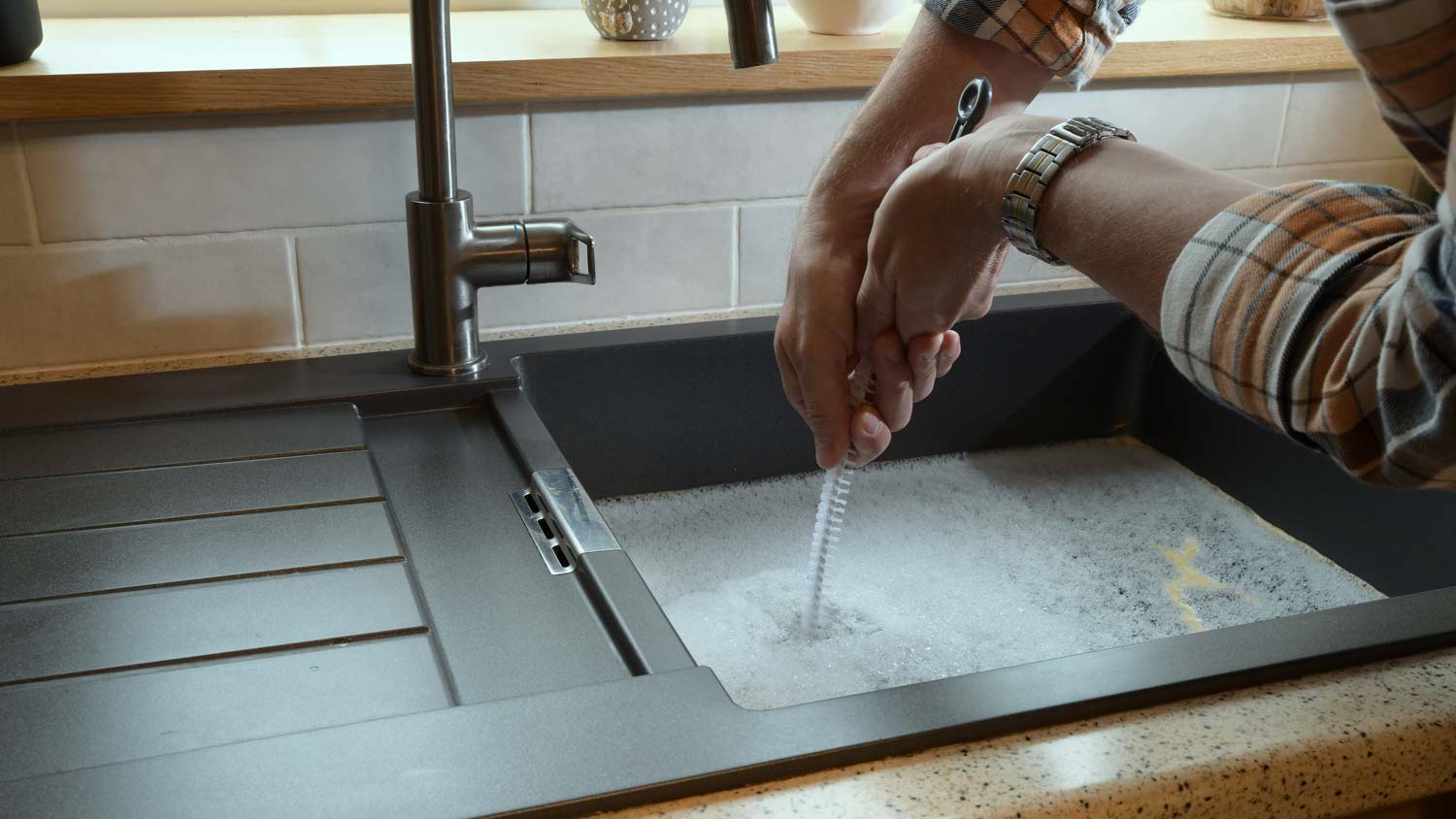
Discover the cost to replace drain pipes in a house, including average prices, key factors, and tips to save on your plumbing project.
With these remedies, drain flies won’t bug you anymore


Sometimes, homeownership feels like you're a landlord to an array of pests who are living rent-free, whether it’s field mice sneaking in through the cracks in your foundation or earwigs totally wigging you out. Drain flies, as harmless as they might be, are a common squatter, but you can evict them ASAP with a few DIY tricks. This complete guide will show you how to get rid of drain flies—and make sure they never return.
Drain flies, or Psychodidae, go by a few names—moth flies, sewer flies, filter flies, sewer gnats, etc. Whatever you call them, make no mistake. They’re not the same thing as fruit flies. You’ll know a drain fly by its specific look. They’re one-sixth to one-fifth of an inch long with a gray or tan body, six legs, and two rounded wings. They’re also a little bit hairy, so they look like tiny moths.
Drain flies can’t actually fly. Rather, they hop around standing bodies of water, like your kitchen sink or shower floor. They lay their eggs in moist, organic matter—like the kind found in drains, pipes, or your garbage disposal. Once hatched, the larvae and pupae feed on the organic matter in your drain and hop out a mature adult in a week to 28 days. Each female fly lays 30 to 100 eggs at a time, so you’ll typically notice a bunch of flies at once.

Drain flies gather in places with wet, organic matter—and you can find them in every state. This includes sewers, septic tanks, compost, grass, bird baths, storm drains, and decaying leaves. It also includes your household drains and anywhere else with standing water. That said, if you have a drain fly infestation, you’ll know it. The signs include:
Adult drain flies along walls in damp areas of your home, like a kitchen or bathroom
A large number of drain flies surrounding a household drain
If you aren’t sure whether you have drain flies or not, you can always check. Seal off your drain with duct tape and let it sit overnight. In the morning, peel back the tape to see if any flies got stuck. You can also remove your drain cover, scrape the film off the side of your drain, and look for larvae. Larvae are thin, tube-like, and tannish in color. Remember that the eggs may be deeper in your pipes than you can reach.
Drain flies are pesky but don’t pose a health risk. You can usually get rid of them with a DIY solution. Before you start, thoroughly clean your sink and drain, using a pipe brush to scrub as far into the drain as you can. After that, try one of the following methods.
Boiling water is hot enough to get rid of adult drain flies, larvae, and eggs hanging out inside your drain and nearby pipes. All you have to do is boil a pot of water and pour it down the drain while it’s still scalding hot. Repeat this process every few days until the flies are gone.
Note: Don’t use this method if you have PVC pipes. A clog can cause the water to sit and melt the PVC.
As most handy homeowners know, baking soda and vinegar are powerful DIY cleaners. To get rid of drain flies, make a solution of:
1/2 cup of baking soda
1/2 cup salt
1 cup of vinegar
Pour the solution down the drain, let it sit overnight, and then wash it away with boiling water. Unless you have PVC pipes, in which case, use warm water.
You don’t just attract flies with honey—you can also attract them with sugar and vinegar. Create a fly trap by filling a bowl with a mixture of:
Water
Sugar
Apple cider vinegar
A few drops of dish soap
Leave the bowl by the infested drain for a few days. The flies are attracted to the sweet mixture, but they’ll get stuck in the soapy water.
Need another DIY fly trap? Fill a jar or mug with one inch of apple cider vinegar, then cover the opening with plastic wrap. Punch tiny holes in the plastic wrap to let the flies enter. They won’t be able to leave.
Sealing your drain is a great add-on method. Use a different method to get rid of larvae and eggs, and eliminate adult flies by sealing off your drain with duct tape. Leave the duct tape overnight to catch flies trying to exit the drain. Repeat this method for about a week.

If your drain flies are ultra-resilient, try using a liquid drain cleaner. These chemical solutions dissolve the type of organic matter that clogs your drain, so they’re super-effective. Just follow the instructions on the package.
Keep in mind that some unclogging solutions are harsh on porcelain, enamel, and pipes. In particular, they can damage older pipes and septic systems built before 1970.
To prevent an infestation, you’ll need to get rid of things that attract flies—which mostly includes standing water, mold, or any decaying organic matter they might want to eat. In this case, cleanliness is a virtue. Once you get rid of drains flies, you can keep the bugs out with these tips:
Keep your drains, sinks, bathtubs, showers, and toilets as clean as possible.
Repair leaky faucets and clogs ASAP (even if it’s just a mild clog that leads to slow drainage).
Run fans and dehumidifiers in humid areas of your home to reduce moisture.
Clean your sewer drains every 18 to 22 months or whenever you notice signs of a clog.
Keep your garbage bins in an area away from your home.
Take out your garbage regularly, especially if it contains rotting fruit and vegetables.
Don’t leave open food containers around the house.
Eliminate areas of standing water in your yard.
Avoid rinsing food down your drain.
If you have a garbage disposal, clean it weekly.
Most homeowners can get rid of drain flies with a little persistence. If you try out a couple of DIY methods and the problem persists week after week, you may want to hire a drain cleaner near you. Even if you can tackle the issue on your own, you may still want to hire someone to clean your main sewage line every 18 to 22 months to prevent drain flies from returning.
For the average homeowner, drain cleaning costs $100 to $275, and cleaning your main sewage line costs anywhere from $100 to $800.
Lawrence Bonk contributed to this piece.
From average costs to expert advice, get all the answers you need to get your job done.

Discover the cost to replace drain pipes in a house, including average prices, key factors, and tips to save on your plumbing project.

If you have a clogged pipe and natural methods are not working, you may need something stronger. How do drain cleaners work? Find out in this guide.

Sewer gas from your kitchen plumbing can create unpleasant odors and health risks. Learn how to identify, remove, and prevent sewer gas issues in your home.

You can tackle a drain blockage with a drain bladder or snake, but the type of clog will determine which one is better.

Hydro jetting can help clear deep plumbing clogs and debris buildup. Use this guide to learn all about hydro jetting and whether it’s the appropriate fix for your problem.

Find out the average cost to remove roots from pipes, what impacts pricing, and expert budgeting tips for root removal, and protect your plumbing.